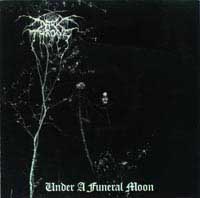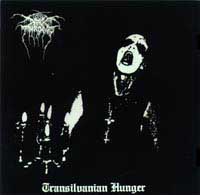Darkthrone
One of the founding bands of the first wave of the fully-formed modern scene in black metal, from Norway and reigning with pride as indolent lords of oblivion. Minimalistic to extremity and mockingly destructive, this band created a sequence of styles unique to their worldview and personality.
Soulside Journey
Peaceville
|
1991
|
|
|
Production: Obscure atmospheric production preserves most tones with reasonable texture but often delivers overpeaked signatures on various instruments.
Review: As death metal came to fruition in 1991 dissenting voices attempted dissonance to the well-established ideals of death, and from that came the rudiments of the next genre. While the first album "Soulside Journey" from Darkthrone clearly belongs in the death metal genre somewhere near other Scandinavian classics Entombed, Dismember, and Therion, the path of its evolution was connecting the breakdown of the rigid structuralism of death metal with a nihilistic and yet melodic and rhythmic sound, integrating the elements of "normal" music that manipulated listeners but were unused in the stripped-down, post-hardcore genre of death metal.
Tracklist:
1. Cromlech
2. Sunrise Over Locus Mortis
3. Soulside Journey
4. Accumulation of Generalization
5. Neptune Towers
6. Sempiternal Sepulchrality
7. Grave With a View
8. Iconoclasm Sweeps Cappadocia
9. Nor the Silent Whispers
10. The Watchtower
11. Eon
Length: 41:46
|
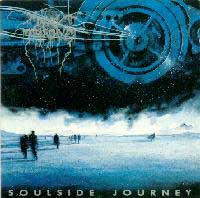
Copyright © 1991 Peaceville
|
Primarily rebellion comes in tempo, less in the overall drop of frequency but the corresponding changed construction in drum beats, where counterpoint construction leaves implied rhythm hanging over the subconflicts of its elements. Using the fast tremelo strum of death metal, however, Darkthrone hang resonating melodic riffs over these engaging but simple drumbeats, changing notes slowly but strumming quickly. As riffs change the drums chase the evolution with variations in fills and addition of other instruments within the drumkit, introducing further voices of dissent in a column of it.
Hoarse and venting the chant of distortion masks the stage of the work, presenting each change as a rhythm and defaulting to reveal a harmonic affinity within these atonal, nihilistic works. Still the guitar leads with shapeshifting riffs and endless inventiveness for microbridges between parts of these meta-patterned songs. These randomly are not random, and follow a rhythm behind the vocal emphasis, the leading strikes of each drum phrase, and the chord-shifting rhythm of each riff and bridge; the complex structure beneath is thus at once both designed and very flexible, permitting Darkthrone the ability to run a gamut of riff styles within the same sequence of tempos.
Though simple in that its riffs are cut from strings of scalar measurement, this music maintains interest by contrasting pieces forcefully; oftentimes songs reveal an evasively addictive cyclic rhythm underneath their composition, where each force presses another into being and then receives its response. This and the combination of hauntingly beautiful melodic overtones within ugly, churning, trudging evil architectures makes this album both intense and chillingly soothing at the same time.
|
A Blaze in the Northern Sky
Peaceville
|
1992
|
|
|
Production: Deliberately garage but with depth for vocals and tonal breadth for guitar, overall very reasonable sound.
Review: Intensely curious as to the nature of evil young Darkthrone promulgated their vision through music which aims to sound random, sloppy, haphazard, simplistic and inscrutable. In that spirit we get this arrangement of songs which celebrate the heaviness of simple nihilism through older styles of music parodied into a sick chorus of angry voices.
The fusion of decayed visions of 1950s crooner rock with three chord punk gives way to Hellhammer-esque trudging, repetitive, but distinctive tune which like thrash songs iterate a single riff through different sub-rhythms to make an impression of essence. Ghoulish voices chant over the plod of drums and the strumming churn of guitar, keeping a rhythm to break for chorus or other paradigm shift, necessitating an artificial pause before the chord change to keep the illusion of demons who never practice their instruments.
Tracklist:
1. Kathaarian Life Code
2. In the Shadow of the Horns
3. Paragon Belial
4. Where Cold Winds Blow
5. A Blaze in the Northern Sky
6. The Pagan Winter
Length: 46:08
|
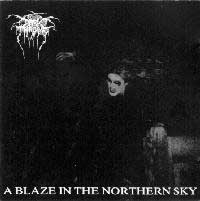
Copyright © 1992 Peaceville
|
Like legs under skirts drums move seductively, using the diffused bass hits to offset the alternate marching of snare and high-hat. Fills are precise and complexity intensity interesting but calculated to look offhand. Demonic mysteries? Atonal, chromatic and deliberately simple riffs; the aesthetic dictates nihilistic sterility of music, and from that Darkthrone have wrought mystical violence in rhythm and context equalization for tone.
|
Under a Funeral Moon
Peaceville
|
1993
|
|
|
Production: The first of the black metal bands to achieve the ascendancy of distortion from guitar effect to overall production aesthetic, Darkthrone added a granularity of organic noise to the music as well the room sound of the production and the cutting of tracks in random lightspeed fades, an aesthetic shift that now has been adopted by even the worst of the imitators.
Review: In a generational attempt to explore the motif of music fashioned from extremely minimalistic collages of elements normally written off as garbage, this album furthers the windblower noise aesthetic of the previous Darkthrone with even further simplified and atonal riffing built upon chaotic patterns allocated to center the logic of its music around nihilism. Aggressive, punk-influenced and extremely harsh and fast guitar tempos are driven by the ambient beat master Fenris, who builds his drums around multiply interconnected streams of layered beats in the same running tempos without missing a chance to diversify the inflection of the ever-changing pattern structure.
Hoarse sawing guitar ranting drives this album but what makes it strong is the underlying principle of the snare-highhat-cymbals rhythmic runs inflected in reference to the strongly dominant vocals, a rhythmic and tonal device that appreciably augments the compelling motion of this music under its bizarre and evil melodic tonal changes. A new theory lurks in the transition of notes across spectrums of pattern already defined within the music, promoting a nihilistic and objectivist worldview of how information links to itself and constantly expands.
Spiritual in its intensity and the drive behind its ecclectic intensity, this album is the masterwork of Darkthrone and their best work before or since. Variety of song structures maintain a consistency through an insistence upon a simplicity tempered by minimalistic but profoundly direct bridges which address the tension created in these seemingly randomly allocated tone centers and offshoot counterpoints. To top it off, the beauty of this cryptic work is that it functions on two levels: the first as highly abstract and intense art promoting a theory of music and information of its own, and the second as motion-oriented metal with power and beauty in its fundamental rhythms and melody.
|
Transilvanian Hunger
Peaceville
|
1994
|
|
|
Production: More desperately distorted and flagrantly low-fi than any previous release in rock or metal, this album uses organic granularity in production to highlight the essential tones within its (complex but minimalistic) melodies.
Review: An album of pure melody running like riverstreams under a pulsing ambient beat with no teleology or intention other than a continuous cycle of aggression and ambiguity brings forth its genius in the complexity of the relations in these deliberately scaled-down simple riffs and melodic interchanges. Highly dissonant in its composition, this music builds spaces to grow in from the seemingly random and nihilistic combinations of notes that are simultaneously familiar in their essential relationships.
Master percussionist Fenriz extends his philosophy of simple drumming to a style where the toms and bass interplay for a constant roughshod grapple of elemental forces as accented by the sinister shadow of a companion cymbal or high-hat, riding each other into a continuity unprecedented in this genre, including archly-satanic battlefield fills that in simplicity and desperation express the dying gasp of a world aflame with its own denial. Over that guitars layer melody in single notes and contrapuntal dissonant patterns, creating a void of extreme ambiguity that demonstrates the doppler effect in music by approaching beat centers with a rising or descending but paradoxically oppositional melody.
Orchestration of construction makes the brilliance of this album; raw patterns fashioned from chaos build entities of sublime profundity from the subconscious parsing of metaphorical structure. The voice of bitter wisdom sounding harsh angular tones above the raging madness acts as commentator; the music stands alone.
|
|
|
|
Production: Trademark blown-out, washed-out, swimmingly overwashing distorted blast of music which amplifies original sounds through breakdown.
Review: Further devolving toward basic pieces of song structure wrought from tonal streams played as melody, Darkthrone add to a full repertoire of black metal styles the Celtic Frost-inspired trudging drone first appearing on their second album. Hiding their instrumentals in a wash of delayed, distorted, and texturally abraded sound Darkthrone overlay melodies in consequential deconstruction, letting the dominoes fall into beautiful sequences of simple, almost predictable, but in contrast epic and beautiful elements.
Under the echoing voice of Fenris drums pace at either running horses or the staggered emphatic tempos of complex marches or dancing. An invocation of Pan in the cloven feet of the toms pounding under snare hits and constant, electromechanical highhat stitching through the background, percussive progressions break down here from running tempos to distended and excessive grinding doom.
Tracklist:
1. En Vind av Sorg
2. Triumphant Gleam
3. The Hordes of Nebulah
4. Hans Siste Vinter
5. Beholding the Throne of Might
6. Quintessence
7. Snø og Granskog (Utferd)
Length: 39:05
|
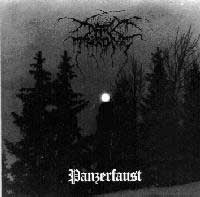
Copyright © 1995 Moonfog
|
In celebration of the nature of Hellhammer behind much of black metal, Dark Throne have resurrected some of the more random rhythmic changes in that style and put them into a more wordly, decadent, and morose style of music. Grinding and stalling sounds throughout the progression of songwriting, and often the trudging battle-beat of early black metal rears its head in a new incarnation.
Guitars work through simple riffs and seemingly demoralized, random lead guitar; their focus leads the song through permutations of its basic idea and justifies the continued platform of the longer percussive phrases which instead of containing each guitar phrase, vary at the evolution of tempo at the instigation of guitar and vocal interaction. Memorable rhythms define the overall tendencies of each song and therefore the meta-meme of both song and album, coming together to create an atmosphere of labored devolution.
For Darkthrone, another marker in the progression of musical decadence, this album takes the morbid rhythmic and structural integration first appearing on "Under a Funeral Moon" and adds to it the melody of "Transilvanian Hunger," toning down both aspects in favor of emphatic rhythm in stalling progressions of recursive strums, an atmospheric invention by repetitive creation of elemental harmonic space. Like all work from this band to date, worth getting for its developmental revelations of black metal, but not for those who fear a droning, corrosive, dispassionate aesthetic.
|
|
|
|
Production: Bass-oriented but representative it brings out the full range of instrumentation without spreading the sound too thin, but loses some of the cool texture that previous lesser efforts implemented. Itís good enough to be reasonable production for a metal album but not enough of an artistic effect to be considered an improvement.
Review: The styles that Darkthrone has innovated in previous albums come through here in partial fragments, with a simpler more conventional style containing many of the bizarre yet simple communications that made Darkthrone famous as one of the blackest bands to play this minimalistic, aggressive style.
Speed tremelo melodies that infold the chaotic into the simple and structural, churning raw Celtic Frost hump-beats and sludge-riffs, and even the basic death metal influences that defined the first Darkthrone album compose the substyles utilized here. Yet these styles are disconnected and form an aesthetic background, but not an aesthetic direction, as earlier albums did that integrated artistic embellishment with a philosophical direction expressed in lyrics, appearance, and composition.
The rhythmic metaprocess is not as prevalent here as on Under a Funeral Moon, and sometimes the simplicity but more so predictability of certain riff element break cohesion further to make songs a listening endurance experience rather than a process of unfolding communication.
Tracklist:
1. Earth's Last Picture
2. Blackwinged
3. Gather for Attack on the Pearly Gates
4. Black Victory of Death
5. Majestic Desolate Eye
6. Blasphemer
7. Ravnajuv
8. The Serpent's Harvest
Length: 35:49
|
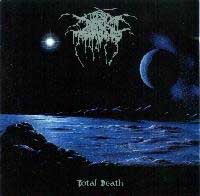
Copyright © 1996 Moonfog
|
Within this constraint Darkthrone pump consistently engaging material in bent pieces of wire riffing and rhythmic augmentation through a competent walking drumbeat and obsessively recursive guitar rhythm riffing.
One additional power is a different melody from the simple illusory riff-melding of Transilvanian Hunger, a melodic sense buried within the chords and their interactions rather than emergent from the repetitive properties of similar notes. These integrations have forced frame-shifting rhythmic structures into the overall structure of the song, forcing the articulation to consider the structural in the context of the rebellious monotone stomp-beat black metal that builds much of the mood around the fewer parts of clarity that deliver the satisfaction of black metal aggression. This in turn forces more completeness into some of these parts, resulting in a finer grade of subsection without any enhancement in guiding mapping of artistic cohesion.
Many of these riffs are recycled, and the excuse of Celtic Frost tribute probably will not work the second album around, but Darkthrone never drop the overarching flow of the song and so keep up a perhaps less intellectualized but nonetheless pulse-engaging pace of the material. Most of this hinges on the racing-pace drumming of Fenriz, who alternates between bass and tom a pattern he accentuates with the echoing whisper of his high-hat, occasionally counterpointing with a noticeably sharp snare. Like all else in this music, relative contrast defines the necessary mood and manipulates its consistency to relate a process to the listener in a sense of the abstract, using relative position to illustrate universality.
Satyr of Satyricon, Ihsahn, and others contribute to these lyrics, which produce both interesting and useless, discombinant subsections of ideas. The relentless forward motion easily encompasses those and any other floating elements into the integument of dark aspect and manipulates it all as the vast circus of despair it is, flinging lost cries into the abyssfully forgetful human maw of perception. Characteristic vocals and riding percussion patterns are here, as are all the styles you would expect, but in the unseen world beneath this stuff is not as intense as earlier works, although in some senses its individual parts are more proficiently composed.
|
|
|
|
Production: Garage underwater crepitative preservation of tenuous sound, but in this all dominant tones come out and others, abraded, remain as distant, thin, distorted sound. Theoretically this is a practice session with vocals recorded over it later and that shows in the clarity of female vocals over the other types of material on these tracks.
Review: Darkthrone explores death metal with this older release, featuring the same style of percussion as on "Soulside Journey" underneath more rugged, basic, experimental metal. The guitars play the beginnings of the somnolent dark melodic lines of later albums with the vocal and rhythmic pacing of the more chant-based tracks off "Under a Funeral Moon." Surprising most is the presence of slower, doomy elements and the structural position of rhythm in these bizarre songs.
Unfinished sounding and often rough, the songs on this album break down our knowledge of song structures, using riffs that are essentially connecting phrases of notes or melodic markers of harmonic parameters. Synchronizing guitar tremelo plays into the thrashing but coordinated drum messaging, which instead of existing as framework in the rigid deathmetal sense plays closer to a jazz style of shadowing and facilitating the work of the other players.
Tracklist:
1. Rex
2. Pure Demoniac Blessing
3. (The) Grimness of Which Shepherds Mourn
4. Sadomasochistic Rites
5. As Desertshadows
6. In His Lovely Kingdom
7. Black Daimon
8. Toward(s) the Thornfields
9. (Birth of Evil) Virgin Sin
10. Green Cave Float
Length: 37:52
|
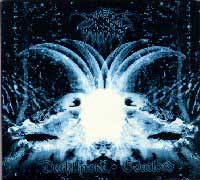
Copyright © 1997 Moonfog
|
Music is built from the simple elements with some of the fascination with inexorable conclusions as found on later Darkthrone releases but here demonstrates a death metallian need to create cities of simple structures to reflect a complex relationship between them all. Pulled through with almost-pop hooks sometimes, guitars work with melody lines over sweeping chord lines and combinatoric power chord riffs.
Trademark Darkthrone vocals, slower and with less dominating echo perhaps, rest on top of these gentle yet savage tracks of metal experimentation, with female vocals and random guest noises on some songs. They lead or ride with musical development but rarely demonstrate any fundamental capacity except as lower end rhythmic calibration. Lead guitar shows bizarre experimentation also, with off-beat inflections and tonal wanderings under a mosaic of shifting tempo.
A Burzum influence in the slower riffs and simple interludes, and a knowledge and focus on musical epiphany, reflect themselves in the composition of these songs which also call to mind some of the rhythmic work of bands like Gorguts, Demilich, or Cadaver. Despite older style production and unfinished nature of this composition, its organization shows over the aesthetic of riff salad and it proves a rewarding listen.
|
The Roots of Evilness (live)
Agustin Records
|
1997
|
|
|
Production: This bootleg recording has three degrees of distorted live performance varying from the reasonable to the nearly incomprehensible in different states of sound capture, maintaing in each case a reasonable framing of the live concert.
Review: From the age of classic Darkthrone a snapshot of the seminal band in several stages of evolution reveals promising degrees of separation between original song and live version, preserving the essential while varying the contextual in a delicious layering of perspective for any die-hard fan of modern black metal. Three sessions of recording exist on this production, although the bulk of the material is the fairly lucid live representation that is the first session.
Esberg, Denmark, captures the young Darkthrone playing the germ material of their first album in an instrumentally dominated passage of rapid events. A nervous speaker begins the set: We have come a long way. In abraded and noisy passages oxidized by analog anomalistic intensity most of the setlist from "Soulside Journey" is heard in crass amplification, with incomprehensibly overdriven vocals selectively appearing in the texture of the song. This section contains enough variation to please a critical but not cynical fan.
Tracklist:
Live in Esberg, Denmark 8/6/90
1. Cromlech
2. Sunrise Over Locus Mortis
3. Soulside Journey
4. Accumulation of Generalization
5. Sempiternal Past/Prescence View Sepulchrality
6. Iconoclasm Sweeps Cappadocia
7. Neptune Towers
8. Dismissal
Thulcandra Demo '88
9. Eon/Thulcandra
10. Archipelago
Live in Norway '92
11. Kathaarian Life Code
Length: 53:56
|
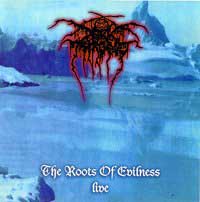
Copyright © 1997 Darkthrone
|
Second comes a recording of Darkthrone's 1988 "Thulcandra" demo, bringing out all of the rawness and base nihilism of this ambitious but sometimes unfocused death metal. A strong tendency toward a slower, throbbing-walk pulse of strobe chant metal juxtaposed with passages of savagely anti-tonal blasting death metal makes this compelling but overwhelmingly disparate effort.
The third session is a single track from a 1992 tour that was played live somewhere in Norway, a scratchy blasted roaring incarnation of what appears to be "Kathaarian Life Code" with fragments of Celtic Frost intruding through similar riffs. As dissonant and murky as this track appears the fundamental power of the song shines through in the "soft background of blower noise" style of earlier Mayhem bootlegs. The newest material on the disk, this track nicely accentuates the progress through earlier material to more degenerative aspects of metal; where the death metal track "Archipelago" was simple atonal and grinding, the harsher faster lighter and more melodic material that finishes this album demonstrates a sublimated simplicity grinding toward a more articulated, violent future.
|
A Night of Unholy Black Metal
Darkthrone
|
1992-1996
|
|
|
Production: In the classic style of bootlegs this recording reveals a good deal about crowd as well as band.
Review: From their most productive period as artists, this vision of Darkthrone in rehearsal and live performances unleashes the minimal nature of work outside a studio and gives life to some of the newer material on this disk. First their definitive works to date are explored live, and next, their older material exhumed first through a live set and after that on an extended "Under a Funeral Moon" rehearsal.
Tracklist:
Live in Oslo, Norway, 06april96
1. Intro
2. Under a Funeral Moon
3. Blackwinged
4. Transilvanian Hunger
5. In the Shadow of the Horns
Live in Finland, 04may91
6. Paragon Belial
7. Ablaze in the Northern Sky
8. Life (unreleased song)
9. no name (unreleased song)
Rehearsal 1992
10. Under a Funeral Moon
11. Unholy Black Metal
12. Summer of the Diabolical Holocaust
13. Crossing the Triangle of Flames
14. Natassja in Eternal Sleep
Length: 53:56
|
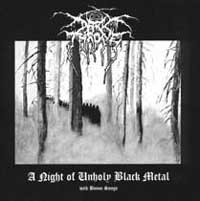
Copyright © 1999 Darkthrone
|
What this reveals is more than a band in transition a band seeking a series of black metal sounds throughout a career that innovated in nearly every area. Through the ultramodernist "Transilvanian Hunger" or the dark and intemperate sparse and doomy material of the Goatlord era, Darkthrone emerge as personality and as a consistent hand of logic in sculpting expressive and yet belligerent sons. This bootleg is mindblowing for its song choice and coverage of vital points in the legacy of Darkthrone. The two unreleased tracks are in a playful version of the style on Goatlord, veering perhaps closer to stoner doom metal with a preference for melodic lead rhythm playing. Highly similar to the Thulcandra demo material, the first track "Life" is a circus of recirculating melody and stalking beats racing in for the kill. It is clearly unfinished as is the other, a nameless track in the same style as the previous but with more emphasis on dominant patterns.
|
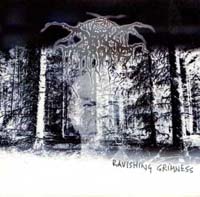
1. Lifeless
2. Beast
3. Claws Of Time
4. Across The Vacuum
5. Ravishing Grimness
6. To The Death
|
Darkthrone - Ravishing Grimness
Darkthrone have lost their passion and gone to a formula using the mid-paced material influenced by first-generation black metal (Celtic Frost, Bathory) in an almost rocklike style with simple mood shifts and Disneyesque symbolism in tone. While this may be the same band that put out epic and experimental works, this album is worth avoiding as it is everything they once were made into a pure product, where there is no variation or organic texture, in the same way a McDonald's "fish patty" once came from a creature that was not square and of a uniform texture.
|
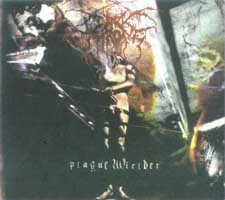
1. Weakling Avenger
2. Raining Murder
3. Sin Origin
4. Command
5. I, Voidhanger
6. Wreak
Length: 42:52
|
Plaguewielder (Moonfog, 2001)
After the limply completed "Ravishing Grimness" the remnants of Darkthrone attempted to focus energies for an album like their older material but, much as the songs they decided were too spacy for release until "Goatlord," these stoner anthems are easily fashioned by masters for whom a series of cruising riffs and choruses almost ecclesiastically oblivious in benevolence are the work of an afternoon. Seemingly dropped through permutations of standard form with well-patented technique, cuttings of riff tapes are visible here in some grand ideas that never get going. For later Darkthrone, this album represents the clearest statement since "Total Death," yet clearly has an ambition of less intensity than the apocalyptic seizure of "Transilvanian Hunger."
|
BLACK | DEATH | HEAVY | SPEED | THRASH | GRINDCORE
Copyright © 1988-2004 the Dark Legions Archive
|



